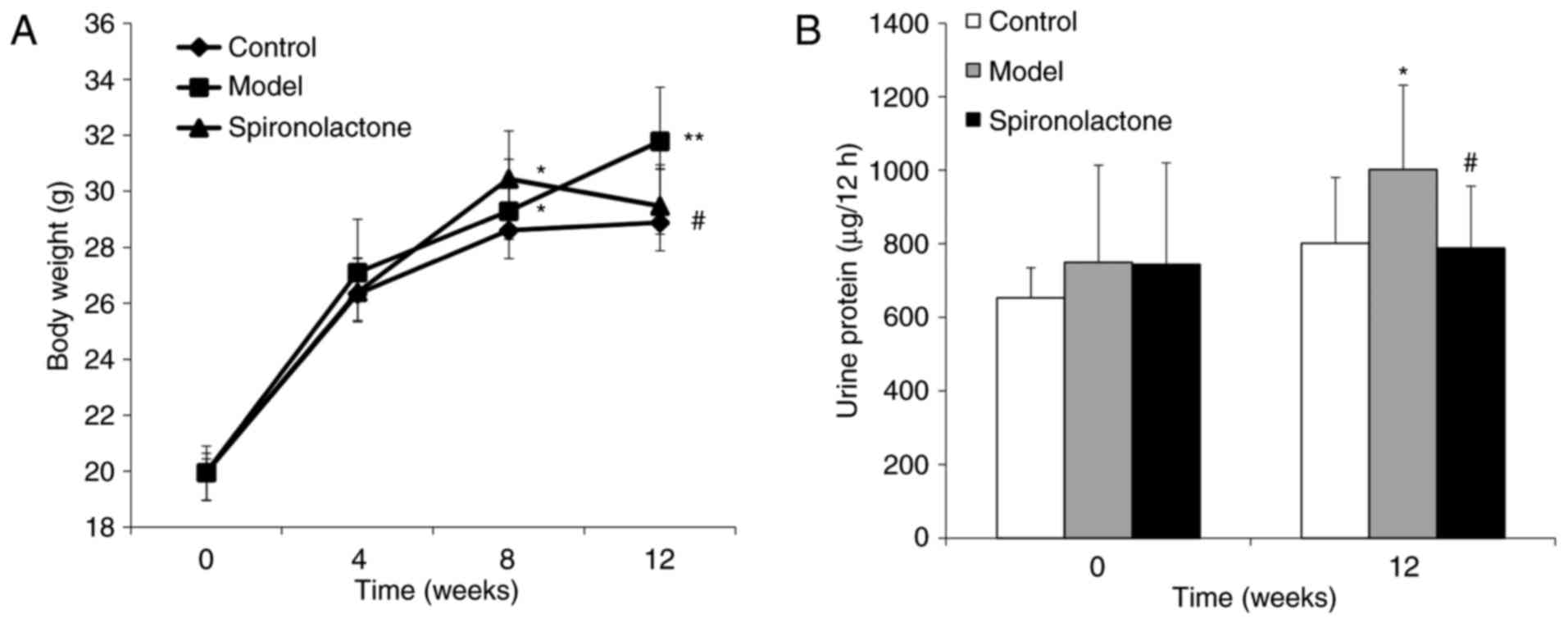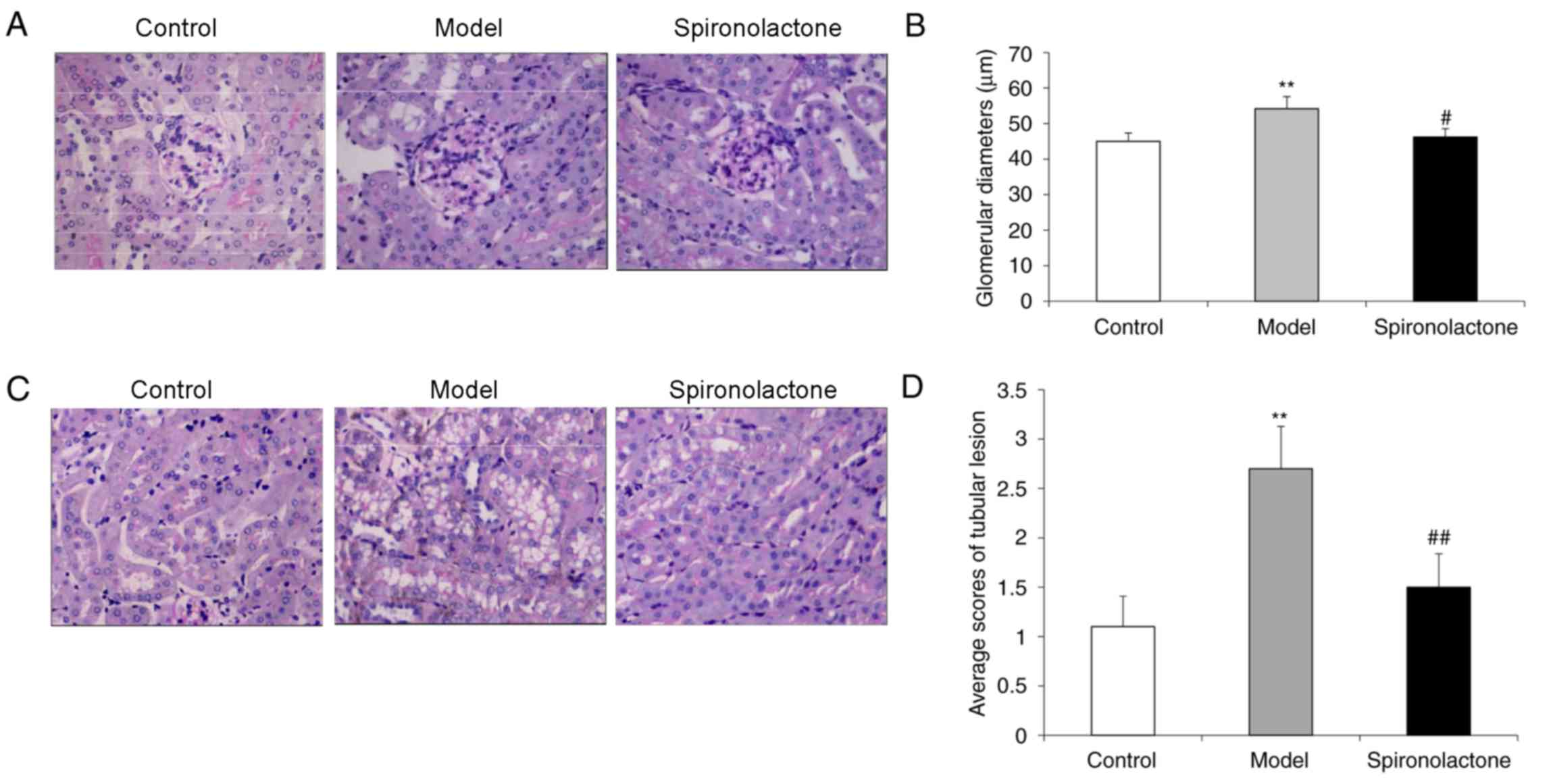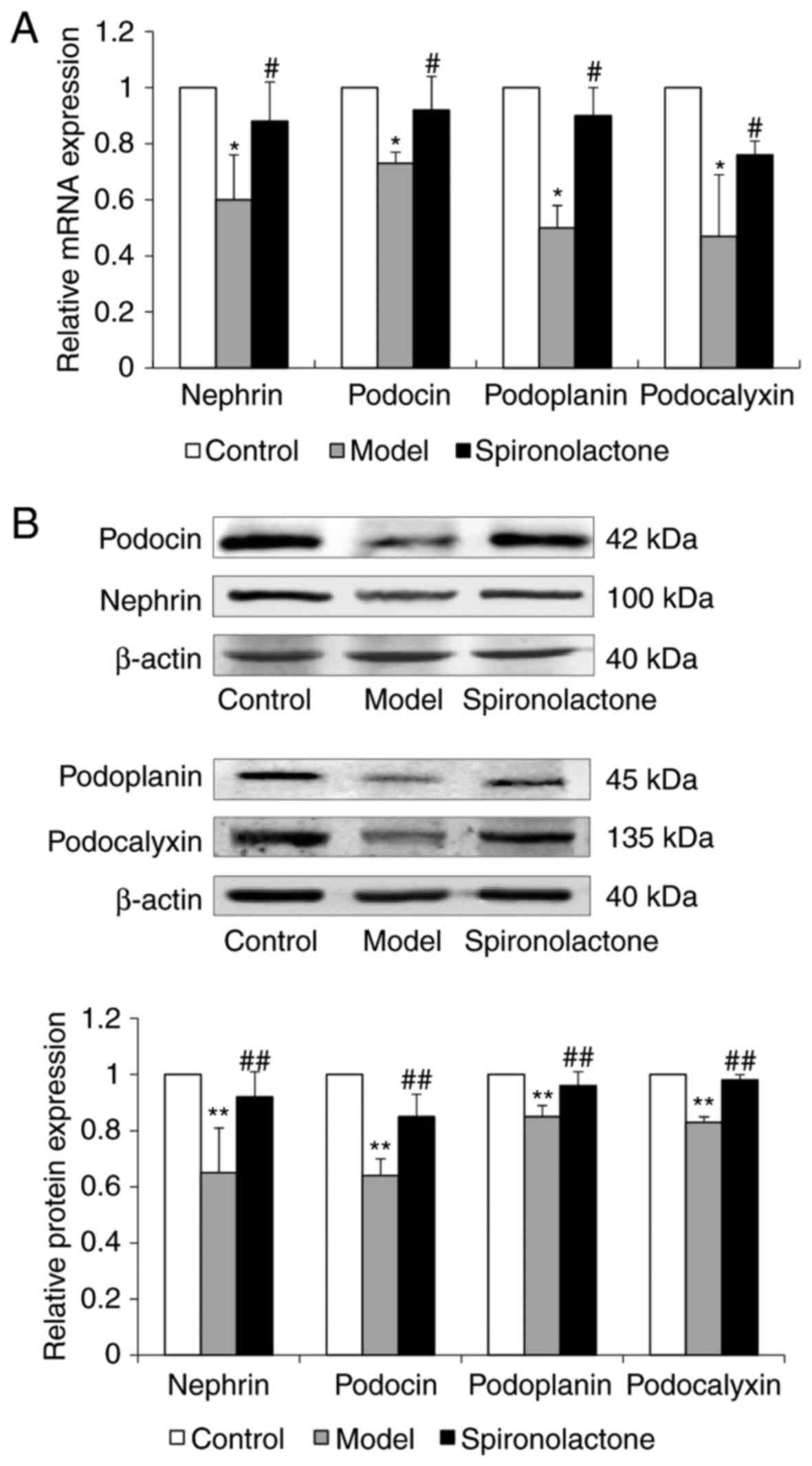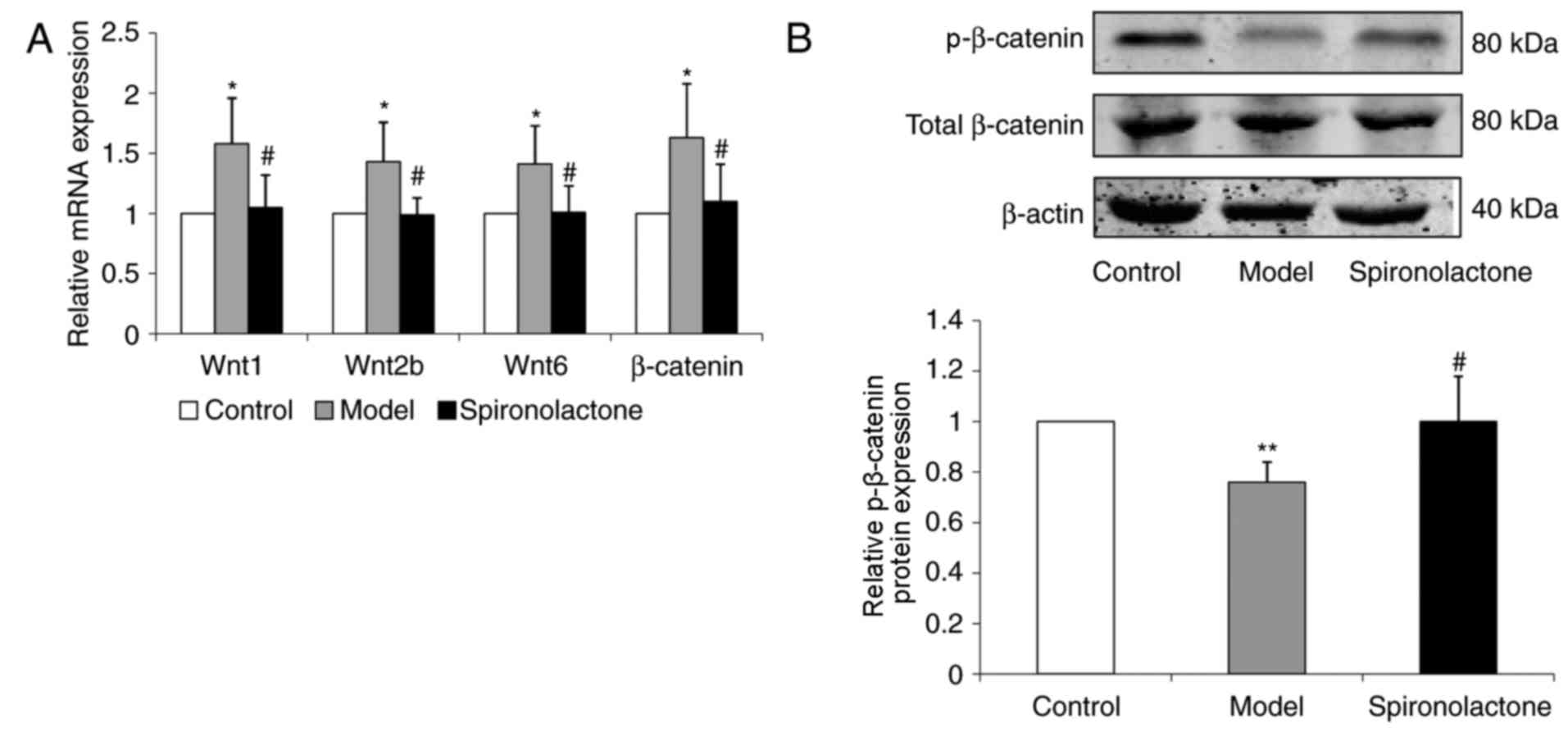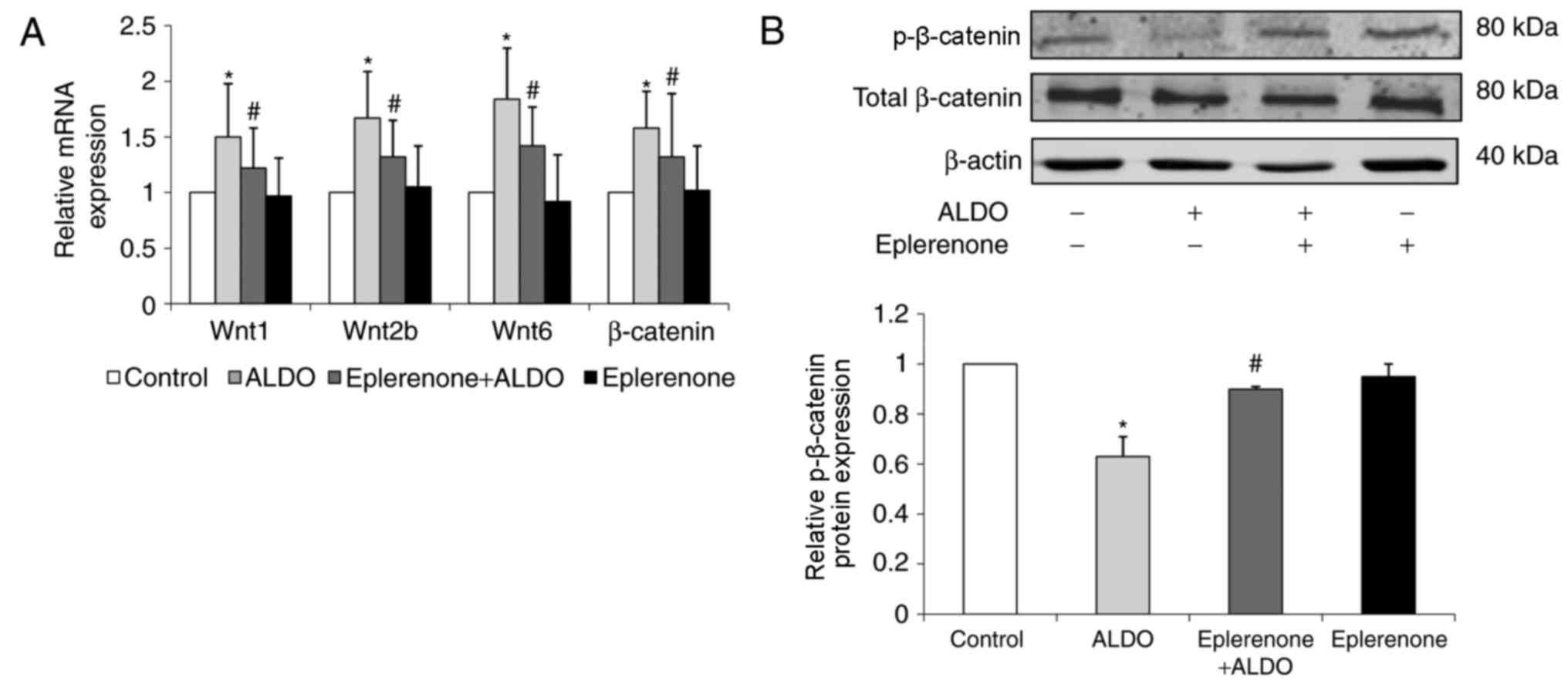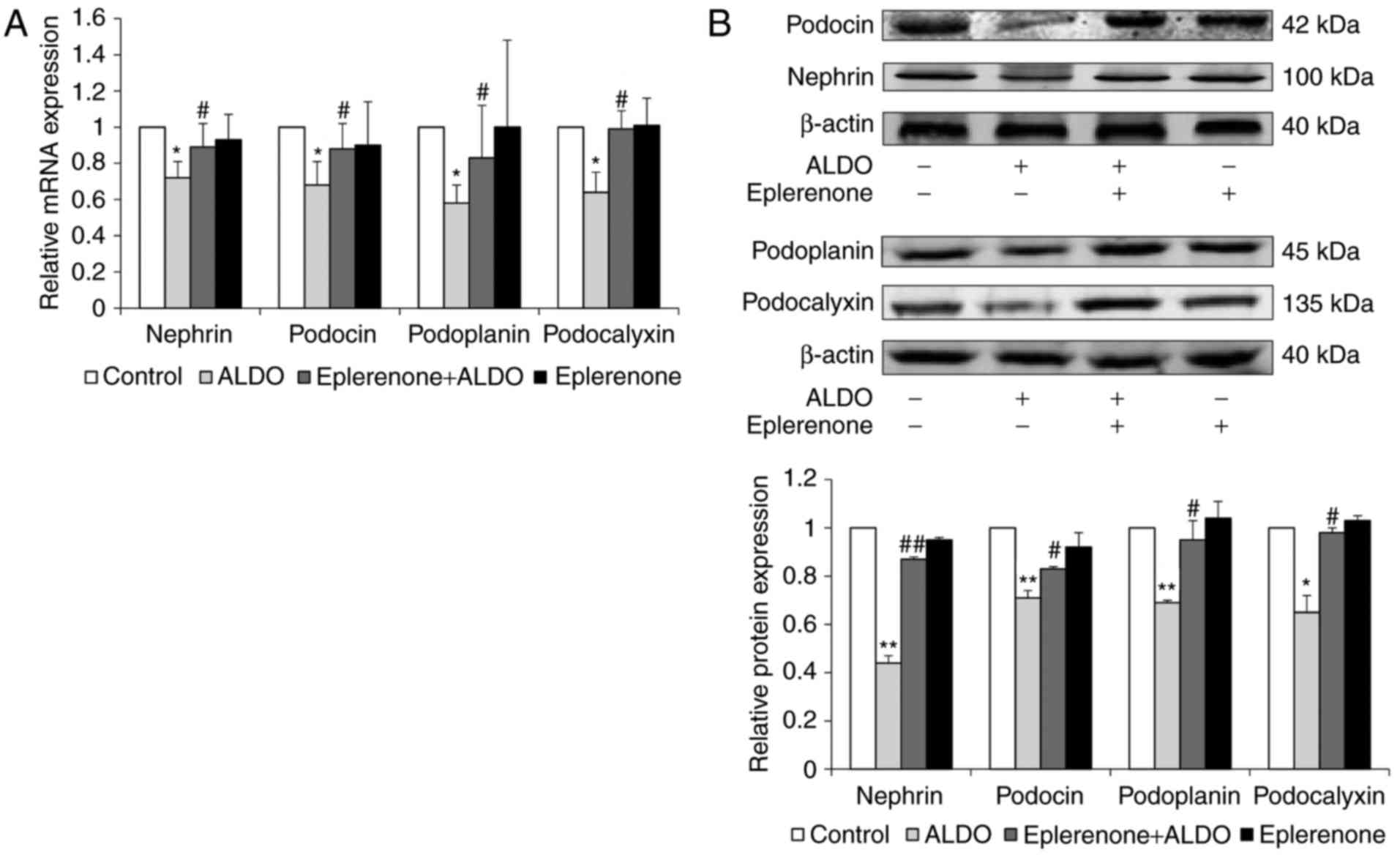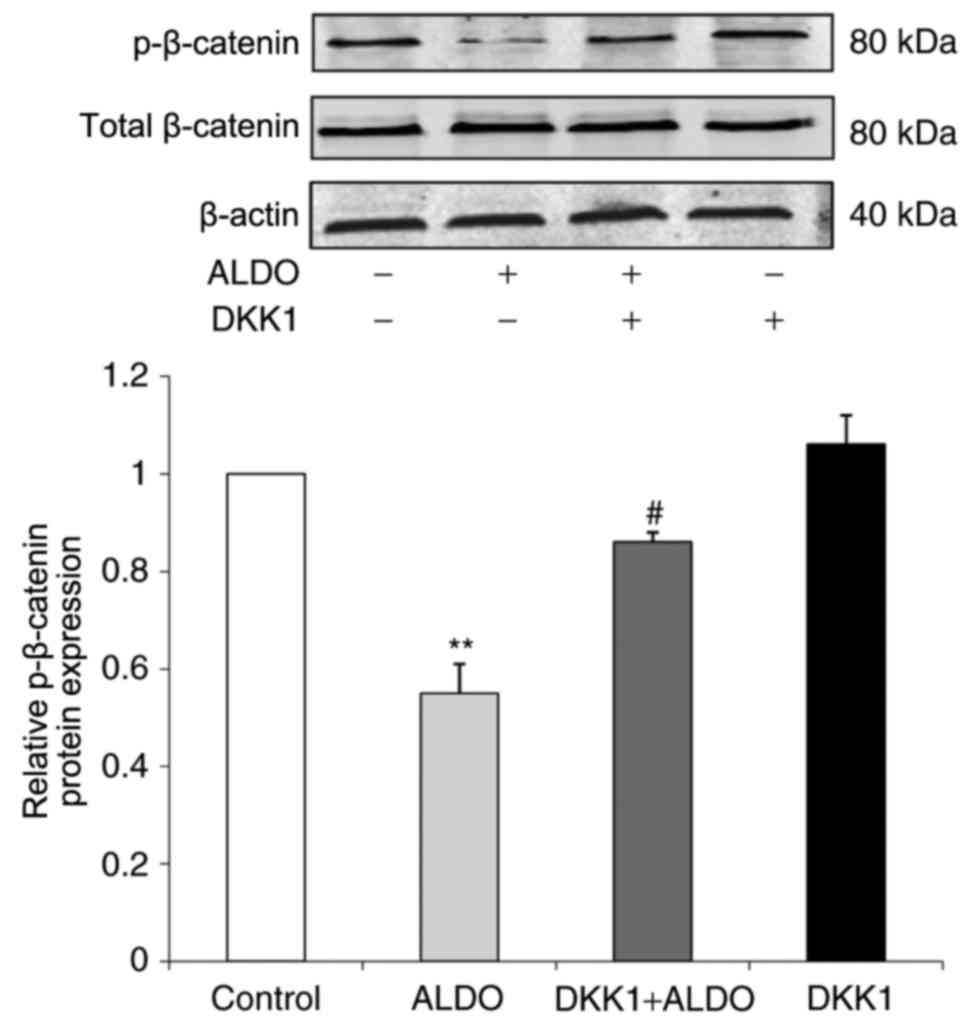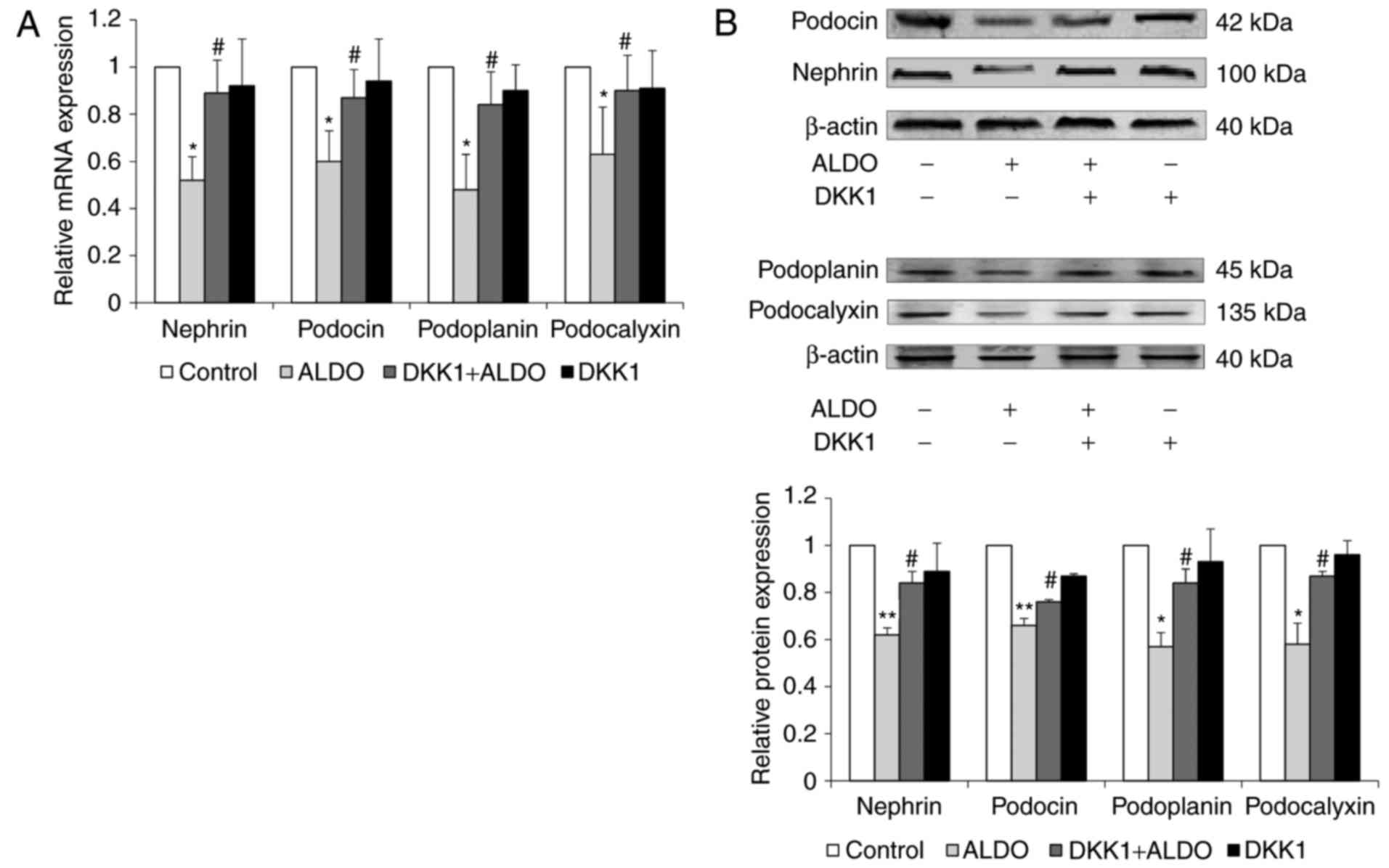Aldosterone is involved in the pathogenesis of obesity-related glomerulopathy through activation of Wnt/β-catenin signaling in podocytes
- Authors:
- Published online on: January 5, 2018 https://doi.org/10.3892/mmr.2018.8386
- Pages: 4589-4598
Abstract
Introduction
Obesity is a worldwide public health concern, the prevalence of which has continuously increased over the past decades (1–3). In 2014, the World Health Organization estimated that ~2 billion people were overweight and ~600 million of these were obese (4). Obesity is an independent risk factor for renal dysfunction and chronic kidney disease, and may directly lead to kidney injury, known as obesity-related glomerulopathy (ORG) (3,5–7). As the number of patients with obesity rises, the incidence rate of ORG is also rapidly increasing. A previous study reported that among 6,818 patients that underwent renal biopsy, the percentage of patients with ORG increased from 0.2% in 1986–1990 to 2% in 1996–2000 (6). Another study reported that among the renal biopsy cases at a Chinese nephrology center, patients with ORG accounted for 3.80% in 2006–2008 and 9.85% in 2010–2015 (7). Therefore, an increasing number of studies are investigating ORG.
The pathological features of ORG include glomerulomegaly with or without focal segmental glomerulosclerosis detectable under light microscopy, and decreased podocyte density and number with increased foot-process width observable under electron microscopy (6–9). The severity of podocyte injury has been correlated with the degree of proteinuria and renal dysfunction; therefore, podocyte injury is considered a hallmark of ORG and serves a pivotal role in the initiation and progression of ORG (9–11).
Previous studies have demonstrated that mineralocorticoid receptor (MR) was expressed in in vitro cultured podocytes as well as in in vivo glomerular podocytes (12–16), and elevated serum aldosterone (ALDO) levels were also reported in the patients with metabolic syndrome as well as in the rat models of metabolic syndrome (12,16). Therefore, it is necessary to determine whether ALDO exposure may exert direct harmful effects on podocytes by binding with MR in the pathogenesis of metabolic syndrome. A study from 2006 reported that a spontaneously hypertensive rats/NDmcr-cp (SHR/cp) rat model of metabolic syndrome exhibited increased proteinuria and podocyte injury (12). Notably, elevated serum ALDO levels were observed in the SHR/cp rats and a positive correlation was determined between serum ALDO levels and proteinuria. Furthermore, administration of eplerenone, a selective MR antagonist, effectively reduced proteinuria and alleviated podocyte injury. These data indicated that ALDO may be involved in the pathogenesis of kidney damage in the metabolic syndrome model (12,14,15). However, renal histological changes were not apparent in this model, and the glomerular diameters were not measured in this study; therefore, the kidney damage in this metabolic syndrome model may not be considered as ORG.
Wnt/β-catenin signaling in podocytes serves a crucial role in integrating cell adhesion, motility, differentiation and survival (17). Podocyte injury and proteinuria were observed in the mouse model of Adriamycin-induced nephropathy (18–20), a mouse model of transforming growth factor (TGF)-β-driven kidney damage (21). In a previous study, it was demonstrated that patients with focal and segmental glomerulosclerosis induced podocyte injury and proteinuria (18). Additionally, in patients with diabetic nephropathy and in mice models of diabetic kidney disease, the proteinuria and podocyte injury was observed (17,19,22). Additionally, accumulating evidence has suggested that activation of Wnt/β-catenin signaling pathway induces proteinuria and podocyte dysfunction, such as diabetic nephropathy and adriamycin-induced nephropathy (8,23,24).
Our previous study demonstrated the activation of Wnt/β-catenin signaling in podocytes in the ORG mouse model (25); however, the pathogenic role of ALDO and the relationship between ALDO and the activation of Wnt/β-catenin signaling in this ORG model have not been explored.
The present study used in vivo and in vitro experiments to investigate the pathogenic roles of ALDO in podocyte injury of ORG and the possible role of activated Wnt/β-catenin signaling in mediating podocyte injury. It was demonstrated that ALDO was involved in pathogenesis of ORG and podocyte lesion. Podocyte injury were observed in ORG model and cultured podocytes were stimulated with ALDO. These alterations were alleviated by Spironolactone and eplerenone (EPL). In addition, the Wnt inhibitory factor Dickkopf protein-1 (DKK1), not only inhibited Wnt/β-catenin signaling activity, but also protected ALDO-induced podocyte injury. The present study suggested that activation of Wnt/β-catenin signaling pathway is involved in podocyte lesion caused by ALDO and is involved in ORG and podocyte injury.
Materials and methods
Animal model and grouping
Male C57BL/6J mice (n=18; age, 6 weeks; weight, 20±2 g; Sibeifu Biology Technology Co., Ltd., Beijing, China) were housed in a 50~60% humidity and temperature (20–26°C)- and light (light/dark cycle: 12 h light, 12 h dark)-controlled animal room of specific-pathogen-free cleanliness grade. Mice were randomly divided into the following 3 groups: i) Control group (n=6), which were fed a common diet ad libitum that contained fat accounting for 10% kcal (Beijing Huafukang Biological Technology Co., Ltd., Beijing, China); ii) ORG model group (n=6), which were fed a high-fat diet that contained fat accounting for 60% kcal (Research Diet, Inc., New Brunswick, NJ, USA) as described by us previously (26); and iii) Spironolactone intervention group (n=6), which also were the high-fat diet, and at week 9 received daily subcutaneous injections of spironolactone (20 mg/kg/d; catalog no. Y0001295; Sigma-Aldrich; Merck KGaA, Darmstadt, Germany), a non-selective MR antagonist, that was dissolved in 60% propylene glycol; mice in the Control group and in the ORG model group received daily subcutaneous injections of 60% propylene glycol only. All mice were sacrificed at the end of 12th week and the kidneys collected. Mice were scarified by 100% carbon dioxide. The filling rate was 20% of the volume of the chamber per minute to achieve animal unconsciousness rapidly and reduce animal pain. The sign of death is the lack of respiration and fading of the eye-color. Once these two phenomena were observed, mice were removed from the box. A portion of the kidney tissue was fixed in 4% neutral formaldehyde solution for 48 h in room temperature, for light microscopy; the remaining of the kidney tissue was rapidly frozen in liquid nitrogen for use in reverse transcription-quantitative polymerase chain reaction (RT-qPCR) and western blotting assays.
All animal care and experimental protocols complied with the US National Institutes of Health Guide for the Care and Use of Laboratory Animals (publication no. 85–23, 1996) and were approved by the Institutional Animal Care and Use Committee of Capital Medical University (Beijing, China).
Cell culture and experimental protocols
A conditionally immortalized mouse podocyte cell line was kindly provided by Professor Maria Pia Rastaldi (San Carlo Hospital, University of Milan, Italy) and cultured as described previously (25). Briefly, podocytes were grown in RPMI-1640 with 10% fetal bovine serum (FBS; Gibco; Thermo Fisher Scientific, Waltham, MA, USA) with mouse recombinant interferon-γ (20 U/ml (IFN-γ; Sigma-Aldrich; Merck KGaA) at 33°C, and subsequently differentiated in RPMI-1640 without interferon-γ at 37°C. Results from preliminary experiments were similar to previously described results of podocytes cultured in serum-containing medium and serum-free medium with 2% FBS (data not shown) following aldosterone and/or eplerenone stimulation (27–29). Based on these date, serum-free medium was used for podocyte culture for subsequent experiments post-stimulation.
In the first set of experiments, podocytes were incubated in RPMI-1640 medium only, in medium containing ALDO (cat. no. A9477, Sigma-Aldrich; Merck KGaA), in medium containing eplerenone (cat. no. E6657, Sigma-Aldrich; Merck KGaA) or in medium containing both eplerenone and ALDO (cells in this group were pre-incubated with eplerenone for 30 min at 37°C, and subsequently incubated with both eplerenone and ALDO). The concentration of ALDO and eplerenone in the media was 10−7 and 10−5 mol/l, respectively. Cells were incubated for 12 or 24 h at 37°C and harvested for RT-qPCR or western blotting assays, respectively.
In the second set of experiments, podocytes were incubated in RPMI-1640 medium only, in medium containing ALDO, in medium containing Dickkopf-related protein 1 (DKK1, a well-known inhibitor of Wnt/β-catenin signaling; cat. no. 5897-DK, R&D Systems, Inc., Minneapolis, MN, USA) or in medium containing DKK1 and ALDO (cells in this group were pre-incubated with DKK1 for 1 h at 37°C, followed by incubation with DKK1 and ALDO). Cells were incubated and harvested for RT-qPCR and western blotting as aforementioned.
Biological parameters
Mouse body weight was measured every 4 weeks and body length was measured at week 12. Nocturnal 12 h urine samples were collected at weeks 0 and 12 to measure urinary protein using a Bradford Protein Assay kit (Beyotime Institute of Biotechnology, Shanghai, China), according to the manufacturer's protocol. Blood and urine samples were collected at week 12 to measure serum triglycerides, serum cholesterol and blood glucose levels, as well as serum and urine creatinine levels using an Olympus AU5400 Chemistry Analyzer (Olympus Corporation, Tokyo, Japan). Following sacrifice, the weight of visceral fat mass was measured as previously described (30) and the weight of kidney was also measured.
The follows formulas were used: Lee's obesity index=[(Body weight (g) ×1,000)1/3]/Body length (cm) (31,32); abdominal visceral fat index=[abdominal visceral fat mass (g)/body weight (g)] × 100% (30); and creatinine clearance rate (ml/min)=[(urine creatinine (µmol/l) × urine volume (ml/min)]/serum creatinine (µmol/l) (33).
Histological examination
Fixed kidney cortical tissues were dehydrated, embedded, sectioned (3 µm) and stained with periodic acid-Schiff reagent. Paraffin production: A portion of kidney tissues were fixed in 4% neutral formaldehyde solution for 48 h. Subsequently, they were dehydrated with 70, 80, 90, 95, and 100% ethanol gradient, xylene transparent and 60°C dipping wax. Paraffin embedding machine made wax, then making paraffin wax slicing machine. PAS slice thickness was 3 µm, and 58°C for 1 h. PAS staining: 3 µm thick paraffin sections were dewaxed, washed with 1% periodic acid for 10 min, then were rinsed using tap water for 5 times and washed once with distilled water. Subsequently, Schiff reagent (cat. no. TR1337, ZSGB-BIO; OriGene Technologies, Inc., Beijing; China) was added for 30 min in the dark, rinsed with tap water for 5 times and washed 3 times with distilled water. Subsequently, hematoxylin Mayer dye was added for 5 min, rinsing with tap water for 5 times and washed 3 times with distilled water, then using hydrochloric acid alcohol differentiation for 10 sec, and rinsing with ethanol 3 times. Finally, xylene was transparent and neutral resin sheet was produces. A total of 20 images of glomerular maximal profiles with vascular pole and/or urinary pole were captured using a confocal microscope (×400 magnification). The two longest perpendicular diameters of the glomerular capillary tufts were measured using the Nikon NIS-Elements Basic Research Image Analysis software (Nikon NIS-Elements Basic Research Image Analysis software 3.0; Nikon Corporation, Tokyo, Japan), and the mean value was calculated (25,26,34). In addition, images of 20 random visual fields containing only tubules and interstitium were captured (×200 magnification), and the relative area of tubules displaying vacuolar degeneration of cytoplasm in each visual field was assessed using a semi-quantitative method, and then their mean value was calculated. A semi-quantitative method described as: ‘Each slice randomly selected with 20 visual fields, the area of vacuolated tubules that accounted for <25, 26–50, 51–75 or >75% of the visual field were given lesion scores of 1, 2, 3 and 4, respectively’ (35). Calculating mean value in every slice, then calculating the mean value of every group.
Reverse transcription and RT-qPCR
Total RNA (50 µg) was extracted from the renal cortex of mouse kidney or 30–40,000 cultured podocytes/dish using the TRIzol RNA isolation system (Invitrogen; Thermo Fisher Scientific, Inc., Waltham, MA, USA) according to the manufacturer's protocol. RNA (2 µg) was reverse transcribed to cDNA with Moloney Murine Leukemia Virus reverse transcriptase (Beijing TransGen Biotech Co., Ltd., Beijing, China) as follows: Incubation for 30 min at 42°C, inactivation in 85°C for 5 min, followed by incubation at 12°C. The synthetic cDNA is preserved at −20°C. qPCR was performed using SYBR-Green labelled kit (TransGen Biotech, Beijing, China) under a Rotor-Gene 6000 thermocycler (Qiagen GmbH, Hilden, Germany). The thermocycling profile was as denaturation follows: Initial denaturation at 95°C for 60 sec, followed by 40 cycles of at 95°C (15 sec), annealing at 60°C (15 sec) and extension at 72°C (45 sec). Gene-specific primers were designed using GenBank (www.ncbi.nlm.nih.gov/tools/primer-blast/index.cgi?LINK_LOC=BlastHome) and synthesized by Beijing SBS Genetech Co., Ltd. (Beijing, China) (Table I). A no template control was used as a negative control. mRNA expression levels of various genes were calculated following normalizing with GAPDH expression. Reactions were performed in triplicate and quantification cycle (Cq) numbers were averaged. Relative mRNA expression levels were calculated according to the formula: 2−(target gene Cq - control gene Cq) ×103 (36).
Western blot analysis
The tissue was removed from the liquid nitrogen and placed on ice and into the homogenizer, where Ripa lysis buffer (R0010-100 ml; Beyotime Institute of Biotechnology) with protease inhibitors was added following homogenization. Subsequently, the suspension was transferred to the sterilization of the EP tube (Eppendorf AG, Hamburg, Germany), and centrifuged at a low temperature high speed centrifuge at 10,000 × g for 10 min, the supernatant was transferred to the EP tube. All incubations were performed on ice. Total protein was extracted from mouse renal cortex or cultured podocytes (200 µg) using Cell Lysis Buffer (Cell Signaling Technology, Inc., Danvers, MA, USA). Lysate samples were boiled for 5 min, and proteins (40 µg) were separated by 10% SDS-PAGE followed by transferred to nitrocellulose membranes (GE Healthcare Life Sciences, Little Chalfont, UK). Following blocking with 5% skim milk in PBS containing 0.1% Tween-20 for 1 h at room temperature, the membranes were incubated with various primary antibodies at 4°C overnight, followed by incubation with the corresponding fluorophore-labeled secondary antibodies at room temperature for 1 h. The primary and secondary antibodies are listed in Table II. The blotted proteins were quantified using an Odyssey Infrared Imaging System (LI-COR Biosciences, Lincoln, NE, USA). β-actin was used as internal loading control. The relative expression level of each target protein was normalized to β-actin. All assays were performed at least in triplicate. The relative level of phosphorylated (p)-β-catenin was expressed as the ratio of p-β-catenin/total β-catenin using image J 1.51j8 (Image J, National Institutes of Health, Bethesda, MD, USA).
Statistical analysis
All data of continuous variables were expressed as the mean ± standard deviation and analyzed using SPSS 16.0 statistical software (SPSS, Inc., Chicago, IL, USA). One-way analysis of variance followed by the Dunnett's test was performed to evaluate the significant differences among groups. P<0.05 was considered to indicate a statistically significant difference.
Results
Spironolactone improves biological parameters of ORG model mice
No significant differences in body weight were identified among the three groups week 0 (P>0.05; Fig. 1A). At week 4, there were no difference in any group (P>0.05). At week 8, body weights in the Model group and the Spironolactone group were significantly heavier compared with the Control group (P<0.05), whereas no significant difference was identified between the Model group and the Spironolactone group w (P>0.05). However, at week 12, body weight in the Spironolactone group was significantly lower compared with the Model group (P<0.05), and the difference between Spironolactone group and Control group was not significant (P>0.05).
At week 12, Lee's index, abdominal visceral fat index and kidney weight were significantly increased in the Model group compared with the measurements of these parameters in the Control group (P<0.01 or P<0.05; Table III), whereas these parameter measurements were significantly decreased in the Spironolactone group compared with the Model group (P<0.01 or P<0.05).
Also at week 12, the levels of serum triglyceride and cholesterol in the Model group were significantly increased compared with the Control group (P<0.05 and P<0.01, respectively; Table III), whereas these parameters were significantly decreased in the Spironolactone group compared with the Model group (P<0.05). No significant difference was identified for blood glucose levels among the three groups (P>0.05; Table III).
There was no significant difference identified for the nocturnal 12 h urinary protein excretion among the three groups at week 0 (P>0.05; Fig. 1B); however, at week 12, urinary protein excretion in the Model group was significantly higher compared with the Control group (P<0.05), and mice treated with spironolactone exhibited a significantly lower level of urine protein compared with the Model group (P<0.05). In addition, creatinine clearance rate in the model group was significantly higher compared with the Control group (P<0.05; Table III), whereas this level was significantly reduced in the Spironolactone group compared with mice in the Model group (P<0.05).
Spironolactone alleviates renal histological lesions in ORG model mice
The average glomerular diameter in kidneys from mice in the Model group was significantly larger compared with the Control group (P<0.01; Fig. 2A and B), and the glomerular diameter in the Spironolactone group was significantly smaller compared with the Model group (P<0.05). The average tubular lesion score in the kidneys from Model group mice was significantly higher compared with mice in the Control group (P<0.01; Fig. 2C and D), whereas the lesion score in the Spironolactone group was significantly lower compared with the Model group (P<0.01).
Spironolactone improves the expression of podocyte-associated molecules in ORG model mice
The mRNA and protein expression levels of podocyte-associated molecules, including nephrin, podocin, podoplanin and podocalyxin, in the kidney cortical tissue was significantly downregulated in Model group mice compared with mice in the Control group (Fig. 3A and B, respectively). Treatment with spironolactone significantly upregulated the mRNA and protein expression of these molecules, compared with the model group.
Spironolactone inhibits the activation of Wnt/β-catenin signaling in ORG mice
The mRNA expression levels of Wnt1, Wnt2b, Wnt6 and β-catenin in the kidney cortical tissue were significantly upregulated in ORG model mice compared with the respective expression levels in the Control group (P<0.05; Fig. 4A). ORG model mice treated with spironolactone exhibited significantly downregulated expression levels of Wnt1, Wnt2b, Wnt6 and β-catenin compared untreated mice in the Model group (P<0.05).
The expression level of p-β-catenin protein was significantly decreased in Model group mice compared with expression in the Control group (P<0.01; Fig. 4B); p-β-catenin protein expression level was significantly increased in Spironolactone group mice compared mice in the Model group (P<0.05).
ALDO-induced activation of Wnt/β-catenin signaling and expression of podocyte-associated molecules are reversed by eplerenone treatment
The mRNA expression levels of Wnt1, Wnt2b, Wnt6 and β-catenin in cultured podocytes were significantly upregulated in the ALDO-treated group compared with the respective expression levels in the untreated Control group (P<0.05; Fig. 5A). ALDO-treated cells that were co-treated with eplerenone exhibited significantly downregulated expression levels of these podocyte-associated molecules compared with the ALDO-only group (P<0.05). The level of p-β-catenin protein expression in cultured podocytes was significantly decreased in the ALDO group compared with the control group (P<0.05; Fig. 5B) and significantly increased in the eplerenone + ALDO group compared with the ALDO-only group (P<0.05).
The mRNA and protein expression levels of additional podocyte-associated molecules, including nephrin, podocin, podoplanin and podocalyxin in cultured podocytes were significantly reduced in the ALDO group compared with expression levels in the Control group (P<0.05, P<0.01; Fig. 6A and B, respectively); the mRNA and protein expression levels of these molecules were significantly upregulated in cells co-treated with eplerenone and ALDO, compared with the respective expression levels in the ALDO-only treatment group (P<0.05, P<0.01).
ALDO-induced downregulation of p-β-catenin protein expression and podocyte-associated molecules expression levels are reversed by treatment with DKK1
The expression level of p-β-catenin protein in cultured podocytes was significantly decreased in the ALDO group compared with the Control group (P<0.01; Fig. 7), and p-β-catenin protein expression was significantly increased in cells co-treated with ALDO and DKK1 compared with the expression level of those in the ALDO-only treatment group (P<0.05).
The mRNA and protein expression levels of the podocyte-associated molecules nephrin, podocin, podoplanin and podocalyxin in cultured podocytes were significantly reduced in cells treated with ALDO compared with untreated cells in the Control group (P<0.05, <0.01; Fig. 8A and B, respectively); the expression levels of these molecules was significantly upregulated in cells co-treated with ALDO and DKK1 compared with the expression levels in those cells in the ALDO-only treatment group (P<0.05).
Discussion
A number of structural changes of podocytes have been observed under electron microscope in patients with ORG and in animal models of ORG, including hypertrophied podocytes, decreased podocyte density and number, and increased foot-process width on the peripheral basement membrane are the most common manifestations (8,12). In addition, podocyte detachment from basement membrane may also be seen in obesity-associated focal and segmental glomerulosclerosis (9–11,37). Recently, it has been reported that an increase in the number of podocalyxin-positive cells in the urine may be used as a biomarker for detecting early kidney damage in obese patients, owing to the possible shedding of podocytes from the glomerular basement membrane into urine during ORG pathogenesis (38). Based on these data, podocyte injury is considered the hallmark of ORG. Therefore, the present study selected podocytes to be used as the principal research object.
The pathogenic mechanism of ORG has not been fully elucidated, and there are many factors that may result in podocyte injury and dysfunction in ORG (8,11). Obese patients (16,35–37) and obese rats (12) often exhibit elevated levels of circulating ALDO. Adipocytes are able to produce a number of ALDO-releasing substances, which stimulate adrenal ALDO secretion independently of angiotensin II (4,11,16,39–42). In addition, adipocytes themselves are able to synthesize and secrete ALDO (39,43). Previous studies have demonstrated that both circulating ALDO and adipocyte-derived ALDO participate in the development of obesity-related hypertension and cardiovascular complications (39,40,42,43). Therefore, the present study conducted a preliminary exploration into whether ALDO participated in ORG pathogenesis.
ORG model mice in the present study exhibited increased urine protein excretion and elevated creatinine clearance rate, glomerulomegaly and podocyte injury, as indicated by the downregulated mRNA and protein expression levels of podocyte-associated molecules. However, ORG model mice treated with spironolactone exhibited a significant reduction of these effects. These results suggested that ALDO may be involved, at least in part, in the pathogenesis of ORG. In cultured podocytes, ALDO treatment significantly reduced the mRNA and protein expression levels of podocyte-associated molecules, whereas co-treatment with eplerenone reversed these effects. These results suggested that ALDO treatment may exert a direct harmful effect on podocytes, perhaps through binding to and activating MRs in podocytes, which may lead to subsequent podocyte injury. Foot processes can be divided into 3 specific membrane zones: basal, lateral and apical regions. Besides nephrin and podocin, the salivary protein podocalyxin in the podocytes can maintain the negative charge. The basal aspect adheres to the glomerular basement membrane firmly via podoplanin. Through the analysis of podocyte proteins in these different membrane regions, it will help understand the podocyte injury (7,8).
It has been suggested that Wnt/β-catenin signaling serves a pivotal role in causing podocyte injury and dysfunction. For example, the activation of Wnt/β-catenin signaling has been observed in a wide range of proteinuric kidney diseases, including in animal models of Adriamycin-induced nephropathy, diabetic kidney disease and TGF-β-driven kidney damage, as well as in patients with focal and segmental glomerulosclerosis or diabetic kidney disease (18–22). The Wnts are part of a family comprising 19 secretory proteins. Upon binding to cell membrane receptors, Wnts induce a series of downstream signaling events, which lead to the dephosphorylation of β-catenin. The activated β-catenin in cytoplasm is subsequently translocated into nucleus, where it regulates the transcription of Wnt target genes, thus controlling myriad biological processes (20,44–46). Therefore, the present study investigated the role of Wnt/β-catenin signaling in ALDO-induced podocyte injury in ORG.
Previous studies have failed to address how Wnt/β-catenin signaling is activated in the ORG model mice and ALDO-induced podocyte injury. Results from the present in vivo and in vitro experiments demonstrated that Wnt/β-catenin signaling was activated in the ORG model mice and in the ALDO-stimulated podocytes, as indicated by the upregulated mRNA expression levels of Wnt1, Wnt2, Wnt6 and β-catenin, as well as the reduction in p-β-catenin protein expression, whereas administration of MR antagonists (spironolactone or eplerenone) significantly improved Wnt/β-catenin signaling activation. In addition, the activation of Wnt/β-catenin signaling was accompanied by podocyte injury, which suggested that activated Wnt/β-catenin signaling may lead to podocyte injury. In order to verify this inference, DKK1, an inhibitor of Wnt signaling, was added in the culture medium of podocytes containing ALDO. The experimental result revealed that DKK1 intervention was able to alleviate ALDO-induced podocyte injury, which further indicated that activated Wnt/β-catenin signaling may be involved in ALDO-induced podocyte injury in ORG.
In conclusion, results from the present study demonstrated that ALDO exerted a direct injury effect on podocytes in vitro and participated, at least in part, in ORG pathogenesis, which caused podocyte injury and proteinuria in vivo. Our studies also show that the activation of Wnt/β-catenin signaling plays a pivotal role in the ALDO-induced podocyte injury. So, In view of the above, it can be concluded that ALDO is involved in the pathogenesis of ORG via activation of Wnt/β-catenin signaling in podocytes.
Acknowledgements
This study was supported by The Beijing Municipal Natural Science Foundation (grant nos. 7112047 and 7152048). The authors thank Dr Xiao-Yi Xu, Dr Yan-Yan Wang, Dr Yuan-Yuan Pei and Dr Li-Jun Sun for their help in conducting experiments.
Glossary
Abbreviations
Abbreviations:
|
ALDO |
aldosterone |
|
DKK1 |
Dickkopf-related protein 1 |
|
MR |
mineralocorticoid receptor |
|
ORG |
obesity-related glomerulopathy |
References
|
Wang Y and Beydoun MA: The Obesity epidemic in the United States-gender, age, socioeconomic, racial/ethnic, and geographic characteristics: A systematic review and meta-regression analysis. Epidemiol Rev. 29:6–28. 2007. View Article : Google Scholar : PubMed/NCBI | |
|
Arroyo-Johnson C and Mincey KD: Obesity epidemiology worldwide. Gastroenterol Clin North Am. 45:571–579. 2016. View Article : Google Scholar : PubMed/NCBI | |
|
Wickman C and Kramer H: Obesity and kidney disease: Potential mechanisms. Semin Nephrol. 33:14–22. 2013. View Article : Google Scholar : PubMed/NCBI | |
|
Xie D and Bollag WB: Obesity, hypertension and aldosterone: Is leptin the link? J Endocrinol. 230:F7–F11. 2016. View Article : Google Scholar : PubMed/NCBI | |
|
Hsu CY, McCulloch CE, Iribarren C, Darbinian J and Go AS: Body mass index and risk for end-stage renal disease. Ann Intern Med. 144:21–28. 2006. View Article : Google Scholar : PubMed/NCBI | |
|
Kambham N, Markowitz GS, Valeri AM, Lin J and D'Agati VD: Obesity-related glomerulopathy: An emerging epidemic. Kidney Int. 59:1498–1509. 2001. View Article : Google Scholar : PubMed/NCBI | |
|
Cheng H, Chen YP, Zhang C, Fang J, Dong HR, Li WG and Zou WZ: Comparative study of clinicopathological features between two kinds of obesity-related glomerulopathy. Clin J Nephrol. 25:261–264. 2009. | |
|
D'Agati VD, Chagnac A, de Vries AP, Levi M, Porrini E, Herman-Edelstein M and Praga M: Obesity-related glomerulopathy: Clinical and pathologic characteristics and pathogenesis. Nat Rev Nephrol. 12:453–471. 2016. View Article : Google Scholar : PubMed/NCBI | |
|
Chen HM, Liu ZH, Zeng CH, Li SJ, Wang QW and Li LS: Podocyte lesions in patients with obesity-related glomerulopathy. Am J Kidney Dis. 48:772–779. 2006. View Article : Google Scholar : PubMed/NCBI | |
|
Zoccali C and Mallamaci F: Obesity, diabetes, adiponectin and the kidney: A podocyte affair. Nephrol Dial Transplant. 23:3767–3770. 2008. View Article : Google Scholar : PubMed/NCBI | |
|
Camici M, Galetta F, Abraham N and Carpi A: Obesity-related glomerulopathy and podocyte injury: A mini review. Front Biosci (Elite Ed). 4:1058–1070. 2012.PubMed/NCBI | |
|
Nagase M, Yoshida S, Shibata S, Nagase T, Gotoda T, Ando K and Fujita T: Enhanced aldosterone signaling in the early nephropathy of rats with metabolic syndrome: Possible contribution of fat-derived factors. J Am Soc Nephrol. 17:3438–3446. 2006. View Article : Google Scholar : PubMed/NCBI | |
|
Shibata S, Nagase M, Yoshida S, Kawachi H and Fujita T: Podocyte as the target for aldosterone: Roles of oxidative stress and Sgk1. Hypertension. 49:355–364. 2007. View Article : Google Scholar : PubMed/NCBI | |
|
Nagase M and Fujita T: Aldosterone and glomerular podocyte injury. Clin Exp Nephrol. 12:233–242. 2008. View Article : Google Scholar : PubMed/NCBI | |
|
Nagase M: Activation of the aldosterone/mineralocorticoid receptor system in chronic kidney disease and metabolic syndrome. Clin Exp Nephrol. 14:303–314. 2010. View Article : Google Scholar : PubMed/NCBI | |
|
Shibata S and Fujita T: Mineralocorticoid receptors in the pathophysiology of chronic kidney diseases and the metabolic syndrome. Mol Cell Endocrinol. 350:273–280. 2012. View Article : Google Scholar : PubMed/NCBI | |
|
Kato H, Gruenwald A, Suh JH, Miner JH, Barisoni-Thomas L, Taketo MM, Faul C, Millar SE, Holzman LB and Susztak K: Wnt/β-catenin pathway in podocytes integrates cell adhesion, differentiation, and survival. J Biol Chem. 286:26003–26015. 2011. View Article : Google Scholar : PubMed/NCBI | |
|
Dai C, Stolz DB, Kiss LP, Monga SP, Holzman LB and Liu Y: Wnt/β-catenin signaling promotes podocyte dysfunction and albuminuria. J Am Soc Nephrol. 20:1997–2008. 2009. View Article : Google Scholar : PubMed/NCBI | |
|
Heikkilä E, Juhila J, Lassila M, Messing M, Perälä N, Lehtonen E, Lehtonen S, Sjef Verbeek J and Holthofer H: β-catenin mediates adriamycin-induced albuminuria and podocyte injury in the adult mouse kidneys. Nephrol Dial Transplant. 25:2437–2446. 2010. View Article : Google Scholar : PubMed/NCBI | |
|
Zhou L and Liu Y: Wnt/β-catenin signalling and podocyte dysfunction in proteinuric kidney disease. Nat Rev Nephrol. 11:535–545. 2015. View Article : Google Scholar : PubMed/NCBI | |
|
Wang D, Dai C, Li Y and Liu Y: Canonical Wnt/β-catenin signaling mediates transforming growth factor-β1-driven podocyte injury and proteinuria. Kidney Int. 80:1159–1169. 2011. View Article : Google Scholar : PubMed/NCBI | |
|
Xiao L, Wang M, Yang S, Liu F and Sun L: A glimpse of the pathogenetic mechanisms of Wnt/β-catenin signaling in diabetic nephropathy. Biomed Res Int. 2013:9870642013. View Article : Google Scholar : PubMed/NCBI | |
|
Li Z, Xu J, Xu P, Liu S and Yang Z: Wnt/β-catenin signalling pathway mediates high glucose induced cell injury through activation of TRPC6 in podocytes. Cell Prolif. 46:76–85. 2013. View Article : Google Scholar : PubMed/NCBI | |
|
He W, Kang YS, Dai C and Liu Y: Blockade of Wnt/β-catenin signaling by paricalcitol ameliorates proteinuria and kidney injury. J Am Soc Nephrol. 22:90–103. 2011. View Article : Google Scholar : PubMed/NCBI | |
|
Liu BL, Chen YP, Cheng H, Wang YY, Rui HL, Yang M, Dong HR, Han DN and Dong J: The Protective Effects of Curcumin on obesity-related glomerulopathy are associated with inhibition of Wnt/β-catenin signaling activation in podocytes. Evid Based Complement Alternat Med. 2015:8274722015. View Article : Google Scholar : PubMed/NCBI | |
|
Pei YY, Yang M, Zuo HL, Wang YY, Dong HR, Cheng H and Zuo ZZ: The establishment of obesity-related glomerulopathy mouse model. Chin J Integr Tradit West Nephrol. 15:110–113. 2014.(In Chinese). | |
|
Toyonaga J, Tsuruya K, Ikeda H, Noguchi H, Yotsueda H, Fujisaki K, Hirakawa M, Taniguchi M, Masutani K and Iida M: Spironolactone inhibits hyperglycemia-induced podocyte injury by attenuating ROS production. Nephrol Dial Transpalnt. 26:2475–2484. 2011. View Article : Google Scholar | |
|
Huang H, You Y, Lin X, Tang C, Gu X, Huang M, Qin Y, Tan J and Huang F: Inhibition of TRPC6 signal pathway alleviates podocyte injury induced by TGF-β1. Cell Physiol Biochem. 41:163–172. 2017. View Article : Google Scholar : PubMed/NCBI | |
|
Ji ZZ and Xu YC: Melatonin protects podocytes from angiotensin II-induced injury in an in vitro diabetic nephropathy model. Mol Med Rep. 14:920–926. 2016. View Article : Google Scholar : PubMed/NCBI | |
|
Rebuffé-Scrive M, Surwit R, Feinglos M, Kuhn C and Rodin J: Regional fat distribution and metabolism in a new mouse model (C57BL/6J) of non-insulin-dependent diabetes mellitus. Metabolism. 42:1405–1409. 1993. View Article : Google Scholar : PubMed/NCBI | |
|
Wang XX, Ye T, Li M, Li X, Qiang O, Tang CW and Liu R: Effects of octreotide on hepatic glycogenesis in rats with high fat diet-induced obesity. Mol Med Rep. 16:109–118. 2017. View Article : Google Scholar : PubMed/NCBI | |
|
Li X, Yang J, Zhu Y, Liu Y, Shi X and Yang G: Mouse maternal high-fat intake dynamically programmed mRNA m6A modifications in adipose and skeletal muscle tissues in offspring. Int J Mol Sci. 17(pii): E13362016. View Article : Google Scholar : PubMed/NCBI | |
|
Oksay T, Yunusoğlu S, Calapoğlu M, Aydın Candan I, Onaran İ, Ergün O and Özorak A: Protective impact of resveratrol in experimental rat model of hyperoxaluria. Int Urol Nephrol. 49:769–775. 2017. View Article : Google Scholar : PubMed/NCBI | |
|
Cheng H, Dong HR, Lin RQ, Sun LJ and Chen YP: Determination of normal value of glomerular size in Chinese adults by different measurement methods. Nephrology (Carlton). 17:488–492. 2012. View Article : Google Scholar : PubMed/NCBI | |
|
Paller MS, Hoidal JR and Ferris TF: Oxygen free radicals in ischemic acute renal failure in the rat. J Clin Invest. 74:1156–1164. 1984. View Article : Google Scholar : PubMed/NCBI | |
|
Livak KJ and Schmittgen TD: Analysis of relative gene expression data using real-time quantitative PCR and the 2(-Delta Delta C(T)) method. Methods. 25:402–408. 2001. View Article : Google Scholar : PubMed/NCBI | |
|
Darouich S, Goucha R, Jaafoura MH, Zekri S, Ben Maiz H and Kheder A: Clinicopathological characteristics of obesity-associated focal segmental glomerulosclerosis. Ultrastruct Pathol. 35:176–182. 2011. View Article : Google Scholar : PubMed/NCBI | |
|
Suwanpen C, Nouanthong P, Jaruvongvanich V, Pongpirul K, Pongpirul WA, Leelahavanichkul A and Kanjanabuch T: Urinary podocalyxin, the novel biomarker for detecting early renal change in obesity. J Nephrol. 29:37–44. 2016. View Article : Google Scholar : PubMed/NCBI | |
|
Dinh Cat AN, Friederich-Persson M, White A and Touyz RM: Adipocytes, aldosterone and obesity-related hypertension. J Mol Endocrinol. 57:F7–F21. 2016. View Article : Google Scholar : PubMed/NCBI | |
|
Kawarazaki W and Fujita T: The role of aldosterone in obesity-related hypertension. Am J Hypertens. 29:415–423. 2016. View Article : Google Scholar : PubMed/NCBI | |
|
Ehrhart-Bornstein M, Lamounier-Zepter V, Schraven A, Langenbach J, Willenberg HS, Barthel A, Hauner H, McCann SM, Scherbaum WA and Bornstein SR: Human adipocytes secrete mineralocorticoid-releasing factors. Proc Natl Acad Sci USA. 100:pp. 14211–14216. 2003; View Article : Google Scholar : PubMed/NCBI | |
|
Luther JM: Aldosterone in vascular and metabolic dysfunction. Curr Opin Nephrol Hypertens. 25:16–21. 2016. View Article : Google Scholar : PubMed/NCBI | |
|
Briones AM, Nguyen Dinh Cat A, Callera GE, Yogi A, Burger D, He Y, Corrêa JW, Gagnon AM, Gomez-Sanchez CE, Gomez-Sanchez EP, et al: Adipocytes produce aldosterone through calcineurin-dependent signaling pathways: Implications in diabetes mellitus-associated obesity and vascular dysfunction. Hypertension. 59:1069–1078. 2012. View Article : Google Scholar : PubMed/NCBI | |
|
Angers S and Moon RT: Proximal events in Wnt signal transduction. Nat Rev Mol Cell Biol. 10:468–477. 2009. View Article : Google Scholar : PubMed/NCBI | |
|
Gordon MD and Nusse R: Wnt signaling: Multiple pathways, multiple receptors and multiple transcription factors. J Biol Chem. 281:22429–22433. 2006. View Article : Google Scholar : PubMed/NCBI | |
|
Clevers H and Nusse R: Wnt/β-catenin signaling and disease. Cell. 149:1192–1205. 2012. View Article : Google Scholar : PubMed/NCBI |



